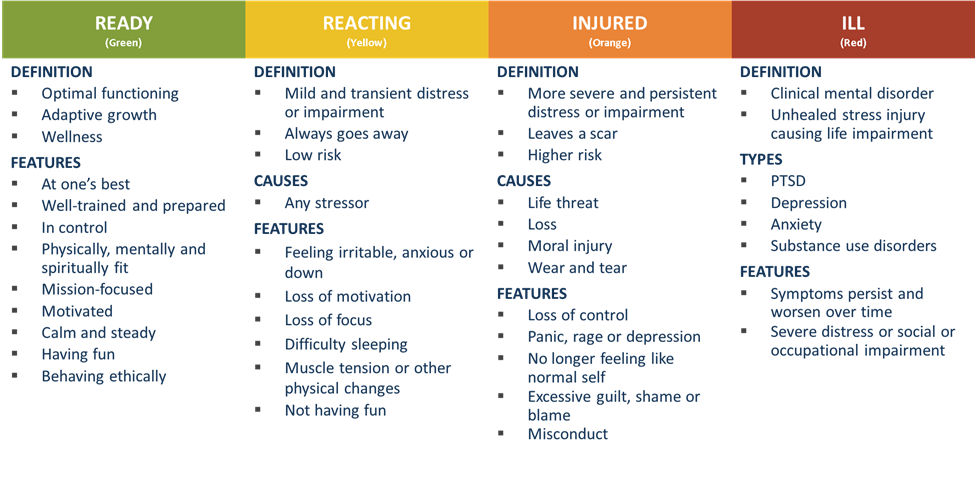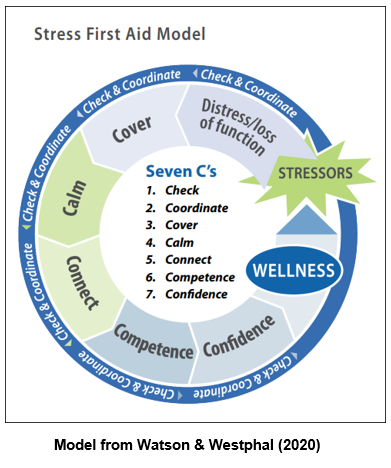Stress First Aid
![]() Print this Article | Send to Colleague
Print this Article | Send to Colleague
 By Christi Nguyen
By Christi Nguyen
As nurses and healthcare providers endure high levels of stress, compassion fatigue and resiliency, it is critical for leaders to identify stress injury and provide resources. Psychological stress over time can cause stress injury. Stress injury is defined as “any severe and persistent distress or loss of ability to function caused by damage to the brain, mind, or spirit after exposure to the overwhelming stressors of fatigue, burnout, trauma, loss, or moral injury” (Shanafelt, Stolz, Springer, Murphy, Bohman, & Trockel, 2020). Left untreated, stress injury can cause severe distress and lead to more serious stress injuries which can be a precursor to medical errors, exit from practice, depression or even suicide. Identifying stress injury and providing resources as needed will make a difference. This article will discuss the Stress First Aid (SFA) Stress Continuum Model to identify and address early signs of stress reactions and the SFA Model.
The SFA Stress Continuum Model (see below) was developed by the U.S. military for the Navy and Marine Corps to assess the level of their stress responses and was later adapted for use by first responders and health care workers (National Center for PTSD, 2022). In the Stress Continuum Model, the four stress zones are ready (green), reacting (yellow), injured (orange) and ill (red). In the yellow zone, an individual may be juggling things well and put things off. Wear and tear over time can put one in the “injured” state of feeling a loss of control; panic, rage or depression; and/or guilt, shame or blame. Checking on each other and being aware of yourself and your team’s behaviour can prevent a person from moving into the unhealthy “ill” state where symptoms are persistent or worsen over time, the person experiences severe distress, or has significant difficulty functioning at work or in their home.
The Stress First Aid model was designed to help people move themselves or their coworkers from the Red and Orange Zones back to the Yellow or Green Zones.

Stress First Aid Stress Continuum Model from National Center for PTSD (2022)
Many healthcare organizations provide different assistance programs as part of their benefits and wellness initiatives. These programs include the Employee Assistance Program, formal/informal peer group support with trained facilitators, and interdisciplinary well-being programs. Another tool leaders can use is the SFA model which has the end goal of moving people towards wellness. The SFA model includes seven actions to identify and address early signs of stress reactions in an “ongoing way” and not just after “critical incidents” (National Center for PTSD, 2022).

The first two core actions are Check and Coordinate. These two core actions are used in the remaining five elements. Check means assessing, observing and listening to determine if the individual may be experiencing significant stress. As the leader, it is important to observe and check in on the team on a regular basis to identify both baseline functioning and behavior, as well as any changes in behavior or functioning (National Center for PTSD, 2022). If there are changes in baseline and help is needed, the leader Coordinates this.
After checking and coordinating, provide safety actions to ensure the person is safe or feels safer. The third element, Cover, is critical if there is a physical safety risk or the person’s own perception of risk is endangering their well-being (National Center for PTSD, 2022). The fourth element, Calm, means reducing the risk for further stress reaction while providing Cover. There is a greater risk for long term health and mental health problems if an individual has post-stress elevated heart rate, respiration, and blood pressure (National Center for PTSD, 2022).
The fifth element, Connect, means helping the individual to stay the same or facilitate them feeling connected to reduce stress. The last two elements are Competence (self-efficacy) and Confidence (hope). Competence is helping the individual build or regain their competence for coping and functioning. As the individual works through this, the last element is building their Confidence (National Center for PTSD, 2022).
The SFA Continuum Model and SFA are useful tools for leaders at the bedside who may be first in line to help their team members at the onset of stress in the reacting (yellow) zone.
References:
National Center for PTSD. Retrieved August 16, 2022.
Shanafelt T, Stolz S, Springer J, Murphy D, Bohman B, Trockel M. A blueprint for organizational strategies to promote the well-being of health care professionals. NEJM Catal. 2020;1(6). doi:10.1056/CAT.20.0266
Watson, P., & Westphal, R.J. (2020). Stress First Aid for Health Care Workers. National Center for PTSD. Available on: www.ptsd.va.gov.

